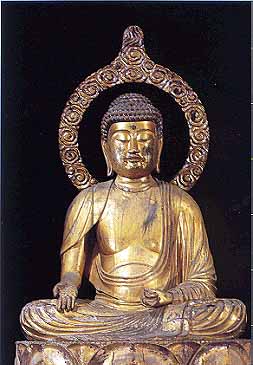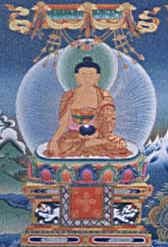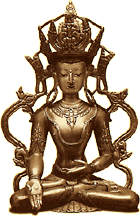| About Us | Site Map | Contact Us |
|
|
| Home | Schools & Teachings | Dharma Centers | Buddha & Bodhisattva Directory | Cosmos |
|
|
Buddha and Bodhisattva Directory
Ratnasambhava
|
In Japanese he is called Ho-sho. (Fig 1) In Tibetan he is called Rin-Chen-Jung-Gnas. (Fig 2 & 3) He is a Dhyani buddha within vajrayana buddhism residing in the south quarter of a mandala. Ratnasambhava is found throughout all four tantra classifications most notably in the Anuttarayoga class. He rules over the element of earth and embodies the skandha of feeling or sensation. His consort is Mamaki, and they represent the transmutation of the poison of pride (spiritual, intellectual and human pride) into the Wisdom of Equality, one sees all beings and the Buddha as having the same nature. Tibetan Buddhists teach that with the Wisdom of Equality one sees all things with divine impartiality and recognizes the divine equality of all beings.
|
| About Us | Free Books | Site Map | Contact Us | ||
| Copyright © 1999-2020 Manjushri. All Rights Reserved. | ||

 The name Ratnasambhava means "the Jewel-born One" or "Origin of Jewels." The three Buddhist Jewels are the Buddha, the Dharma and the Sangha.
The name Ratnasambhava means "the Jewel-born One" or "Origin of Jewels." The three Buddhist Jewels are the Buddha, the Dharma and the Sangha.
 Ratnasambhava's mantra is Om Ratnasambhava Tram. His body is yellow in color and the right hand is placed in the mudra of varada - supreme generosity. It is the gesture of giving or charity, which portrays him offering compassion and protection to his disciples. He is peaceful in appearance, with one face and two hands. The animal that upholds Ratnasambhava's throne is the horse, denoting impetus and liberation.
Ratnasambhava's mantra is Om Ratnasambhava Tram. His body is yellow in color and the right hand is placed in the mudra of varada - supreme generosity. It is the gesture of giving or charity, which portrays him offering compassion and protection to his disciples. He is peaceful in appearance, with one face and two hands. The animal that upholds Ratnasambhava's throne is the horse, denoting impetus and liberation.
 He is sometimes shown holding his symbol (Mudra), the ratna (jewel) or chintamani (wish-fulfilling jewel that grants all desires). The chintamani is a symbol of the liberated mind. The ratna is often depicted in a threefold form as the tri-ratna signifying the union of Buddha, Dharma and Sangha.
He is sometimes shown holding his symbol (Mudra), the ratna (jewel) or chintamani (wish-fulfilling jewel that grants all desires). The chintamani is a symbol of the liberated mind. The ratna is often depicted in a threefold form as the tri-ratna signifying the union of Buddha, Dharma and Sangha.